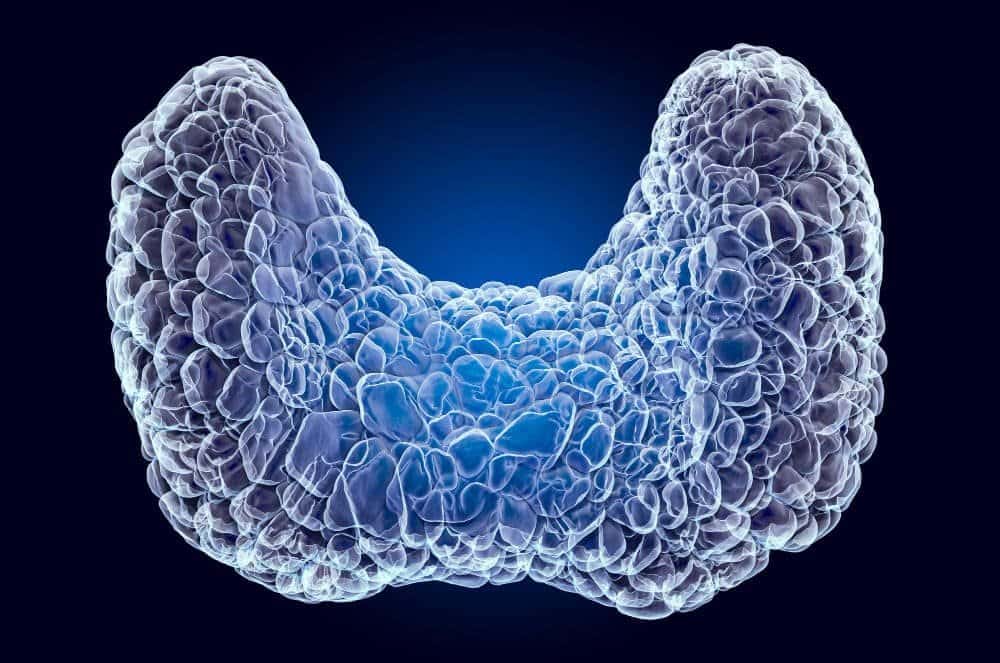An enlarged thyroid gland, often noticed as a swelling or lump in the neck, is a common condition. But what happens when this seemingly simple goiter starts to overproduce thyroid hormone, throwing your body’s metabolism into overdrive? This condition is known as a toxic multinodular goiter, and it’s a significant health concern that requires a comprehensive understanding and effective treatment.

What Exactly is a Toxic Multinodular Goiter? 🤔
A multinodular goiter (MNG) refers to a thyroid gland that has multiple nodules (lumps) and overall enlargement (goiters).
In many cases, the condition is benign, with normal thyroid hormone levels (called euthyroidism) or even hypothyroidism in some patients.
When one or more nodules become autonomous (i.e. they function independently of TSH control) and secrete excess hormone, the process becomes toxic multinodular goiter, a known cause of hyperthyroidism.
Toxic Multinodular Goiter vs. Graves’ Disease
While both conditions cause hyperthyroidism, their origins are very different. Understanding this distinction is key for proper diagnosis and treatment.
| Feature | Toxic Multinodular Goiter | Graves’ Disease |
|---|---|---|
| Primary Cause | Autonomous, hormone-producing nodules within an enlarged, lumpy thyroid . | An autoimmune disorder where the body produces antibodies that stimulate the entire thyroid gland . |
| Thyroid Appearance | Enlarged and lumpy, with multiple nodules of varying sizes. | Typically smoothly and diffusely enlarged (a diffuse goiter). |
| Onset of Symptoms | Gradual and insidious, often developing over many years in older adults . | More rapid and dramatic onset, often affecting younger individuals. |
| Eye Symptoms | Not present. | Often associated with specific eye symptoms (Thyroid Eye Disease), like bulging eyes. |
| Underlying Mechanism | Somatic mutations within thyroid cells . | Autoimmune process involving TSH-receptor antibodies . |
Both conditions are associated with increased long-term health risks if left untreated, though the specific causes of mortality can differ, with Graves’ disease showing a higher risk of cardiovascular issues compared to toxic nodular goiter.
Why & How a Multinodular Goiter Becomes Hyperthyroid

The Starting Point: Nodular Growth
- Many patients begin with a simple goiter or a nodular goiter where thyroid enlargement and nodules develop, often due to iodine deficiency, diet, genetic factors, and environmental stresses.
- Over years, the gland exhibits heterogeneity, with follicular cells behaving differently across nodules.
Mutation & Autonomy
- In some nodules, mutations—especially in the TSH receptor gene—give them autonomous qualities. These nodules no longer respond to TSH levels but instead produce hormone on their own.
- Once one or more nodules produce excess hormone, they suppress TSH, which in turn represses normal thyroid tissue, turning it relatively “silent.”
- The result is a feedback imbalance: low TSH, high thyroid hormones (T3, T4) — the hallmark of thyrotoxicosis.
The Role of Size & Growth
- Larger nodules (often > 3 cm) tend to have a higher risk of becoming toxic.
- The long time a goiter has existed (i.e. the larger or bigger and older the nodules) increases the chance that a nodule will lead to hyperfunction.
- Additional risk factors include iodine repletion in previously deficient areas: giving too much iodine can push a pre-existing nodular thyroid into a hyperthyroid state (the Jod-Basedow ).
Thus, toxic MNG is not a sudden jump — it’s more often the result of a longstanding enlargement and acquisition of mutations that enable inappropriate hormone production.
Recognizing the Symptoms: Is Your Goiter Overactive? 😟
Because a toxic multinodular goiter often develops slowly, the symptoms of hyperthyroidism can be subtle at first, especially in older patients. You or your family might notice changes before you connect them to a thyroid problem. Common symptoms include:
- Heart-Related: Palpitations, a rapid or irregular heartbeat, and increased blood pressure.
- Metabolic: Unexplained weight loss despite a normal or increased appetite.
- Neurological: Nervousness, anxiety, irritability, and a fine tremor, especially in the hands.
- General: Increased sweating, heat intolerance, fatigue, and muscle weakness.
- Compressive Symptoms: If the goiter is particularly large, it can also cause pressure-related symptoms like difficulty swallowing, a choking sensation, hoarseness, or even breathing difficulty.
Diagnosis: How Do We Confirm It?
Laboratory Tests
- TSH becomes suppressed when hyperthyroidism is present
- Free T4, Free T3 are elevated (or in some cases, T3 is elevated first)
- In some cases, autoimmune antibodies (to exclude Graves) are checked
Imaging and Nodule Assessment
- Ultrasound is used to detect solid nodules, measure size, and assess features (e.g. cystic vs solid)
- Radioactive iodine (RAI) uptake scan can show “hot” (autonomous) nodules and the suppression of the rest of the gland
- Biopsy (FNA) is used if a nodule shows suspicious features to rule out cancer (though most nodules in MNG are benign).
What the Findings Show
- Multiple solid nodules in the thyroid
- One or more hyperfunctioning nodules on scan
- Suppressed TSH, elevated hormone levels
- No or minimal uptake in the rest of the gland
If there is a suspicious nodule or a sudden change in size, malignancy must be considered. Some studies report that cancer appears in a minority of nodules in multinodular goiters.
How Frequent Is Toxic Multinodular Goiter?
- In the U.S., toxic nodular goiter (which includes toxic multinodular forms) accounts for 15–30% of hyperthyroidism cases, making it second only to Graves disease.
- In iodine-deficient regions, the proportion is even higher; in some studies, it’s the leading cause of hyperthyroidism.
- Some sources estimate 5% of hyperthyroid patients in general may have toxic MNG.
- In epidemiology reports, the incidence can vary—e.g. 6.5 per 100,000 in Sweden for toxic nodular goiter broadly.
In short, while not universal, toxic MNG is a common and important contributor to hyperthyroid disease, particularly in older adults and in areas with past iodine deficiency.
Risks & Complications
If left untreated, toxic multinodular goiter can lead to:
- Cardiac complications: atrial fibrillation, tachycardia, cardiomyopathy
- Bone loss / osteoporosis because of high thyroid hormone activity
- Thyroid storm (rare but serious)
- Compression risk: especially if the goiter is very large, causing difficulty breathing or swallowing by pressing on the trachea or esophagus
- Hypothyroidism after excessive therapy (especially with radioactive iodine or surgery)
- Occasional cancer in nodules—even though most nodules are benign
Thus, early diagnosis and considered treatment decisions matter.
Treatment Options: From Drugs to Intervention 🌱
When toxic nodules are confirmed, the goal is to return hormone levels to normal and manage the gland’s size and pressure effects.
- Antithyroid Medication
- Drugs like methimazole or propylthiouracil may control hormone production temporarily
- Not often used as long-term monotherapy in MNG because nodules may recur or escape control
- Radioactive Iodine (RAI):
- I-131 is used to selectively ablate excess functioning thyroid tissue
- Because of nodular heterogeneity, sufficient dosing is key
- Occasionally, repeated treatment or surgical backup is needed. Medscape
- Surgery (Thyroidectomy / Lobectomy)
- In cases of large goiters causing compression or suspicion of cancer
- Removes nodules and stops hormone overproduction
- Risks: hypothyroidism, surgical complications, scar
Modern Minimally Invasive Options
For patients wanting less invasive alternatives, especially when surgery is risky or undesirable, interventional radiology offers:
- Radiofrequency Ablation (RFA): Targeting individual nodules with thermal energy to shrink them while preserving rest of gland
- Microwave Ablation (MWA): Similar principle using microwave energy
- Thyroid Arterial Embolization: Blocking blood flow to parts of the gland to shrink them over time
These techniques aim to reduce the hormonally active mass while limiting damage to healthy tissue. In many cases, they help reduce symptoms, decrease hormone levels, and shrink nodules.
In the hands of a specialist like Dr. Samir Abdel Ghaffar, these options may serve as powerful choices for patients who prefer to avoid full surgery or radioactive iodine.
Choosing the Right Approach: What to Consider
- Size, number, and location of nodules (some may be inaccessible)
- Degree of hyperthyroidism (mild vs overt)
- Presence of compression symptoms
- Patient age, comorbidities, and preference
- Risk of hypothyroidism after treatment
- Cancer risk or suspicion in any nodule
- Likelihood of regrowth or new nodules developing
In many cases, a team approach—including endocrinologists, surgeons, and interventional radiologists—ensures tailored care.
Key Takeaways & Wrap-Up
- Multinodular goiter can evolve into toxic multinodular goiter when one or more nodules become autonomous and produce excess hormone.
- It is a significant cause of hyperthyroidism—second only to Graves disease in many populations.
- The shift to hormone overproduction involves cellular mutations, nodule growth, and suppression of normal thyroid tissue.
- Symptoms include both hyperthyroid signs (weight loss, palpitations, heat intolerance) and goiter signs (neck swelling, pressure on structures).
- Diagnosing toxic MNG involves blood tests, imaging, functional scans, and sometimes biopsy.
- Treatment options range from medications and radioactive iodine to surgery and newer minimally invasive interventions (ablation, embolization).
- A specialist like Dr. Samir Abdel Ghaffar can help evaluate and offer modern, patient-friendly options.

 العربية
العربية 

